Have you ever wondered why Boracay Island is one of the most famous tourist destinations in the world? What gives it that undeniable allure that keeps travelers coming back for more? Is there more to this tropical paradise than meets the eye?
Boracay, also known as the “Jewel of the Philippines,” is renowned for its breathtaking beauty, powdery white sand, and crystal-clear waters. It’s no wonder it has been consistently recognized as one of the best islands globally. But what sets Boracay apart from other beach destinations?
Join us on an exploration of Boracay’s beauty as we delve into its hidden gems, stunning beaches, exciting water sports activities, vibrant culture, and delectable cuisine. Get ready for an unforgettable journey through this enchanting island that promises to captivate your senses and leave you yearning for more.
Key Takeaways:
- Boracay Island is renowned for its powdery white sand and crystal-clear waters.
- It has consistently been recognized as one of the best islands in the world.
- Boracay offers a wide range of activities for all types of travelers.
- The island is a culinary haven, with a diverse range of gastronomic delights.
- Boracay’s rich cultural heritage is showcased through its lively festivals and traditions.
Tropical Paradise
Boracay Island is a tropical paradise that captivates travelers with its breathtaking natural beauty. Situated in the Philippines, this stunning island is renowned for its crystal azure waters, powdery white sand, lush flora and fauna, and vibrant marine life. It comes as no surprise that Boracay has been recognized as one of the best islands in the world by esteemed travel publications like Conde Nast Traveler and Travel+Leisure.
Visitors to Boracay are treated to a postcard-worthy escape as they immerse themselves in the island’s idyllic landscapes. Whether you’re lounging on the pristine beaches, exploring the vibrant coral reefs, or taking a leisurely stroll along the picturesque coastline, the tropical paradise of Boracay promises unforgettable moments.
Crystal Clear Waters and Pristine Beaches
Boracay’s crystal clear waters and powdery white sand beaches are the epitome of paradise. From the famous White Beach, a stunning stretch of coastline that offers breathtaking sunsets, to the lesser-known gems like Puka Beach and Diniwid Beach, there is a beach for every preference. Whether you’re seeking tranquility or a vibrant beach scene, Boracay’s shoreline will exceed your expectations.
Thrilling Water Sports and Diverse Marine Life
Boracay is not only a haven for beach lovers but also a playground for adventure seekers. The island offers an array of thrilling water sports activities, such as stand-up paddleboarding, kite surfing, snorkeling, and scuba diving. Dive into the crystal-clear waters and discover a vibrant marine ecosystem teeming with colorful coral reefs and exotic marine species.
Award-Winning Destination
“Boracay’s natural beauty and tropical charm have earned it a place among the best islands in the world, as recognized by Conde Nast Traveler and Travel+Leisure. With its stunning landscapes and vibrant ecosystem, this paradise island continues to captivate travelers from around the globe.”
Experience world-class hospitality and indulge in gastronomic delights as you explore the island’s vibrant culture and savor its mouth-watering culinary offerings. From local flavors to international cuisine, Boracay’s food scene is as diverse as its natural wonders.
Boracay Island truly lives up to its reputation as a tropical paradise and one of the best islands in the world. Its unparalleled natural beauty, thrilling activities, and rich cultural heritage make it a must-visit destination for travelers seeking an unforgettable getaway. Embark on a journey to Boracay and discover why it is hailed as a tropical paradise by travel enthusiasts worldwide.
Beautiful Beaches
Boracay Island is renowned for its breathtakingly beautiful beaches. While White Beach is the main attraction, there are several nearby islands and beaches that offer equally stunning beauty. Exploring these natural wonders is a must for any visitor to Boracay.
Crystal Cove Island
Crystal Cove Island is a hidden gem known for its crystal-clear waters and majestic rock formations. Visitors can explore the island’s two caves and enjoy snorkeling in the vibrant marine life-filled waters.
Piknikan Island
Piknikan Island is a tranquil paradise perfect for a peaceful getaway. It features secluded beaches, coconut palms, and breathtaking views of the surrounding azure waters. Relax under the shade of a palm tree or take a dip in the pristine waters.
Crocodile Island
Crocodile Island is a haven for underwater enthusiasts. Its vibrant coral reefs are teeming with marine life, making it an ideal spot for snorkeling or diving. Marvel at the colorful coral formations and swim alongside tropical fish.
Hinugtan Beach
Hinugtan Beach is a secluded stretch of powdery white sand that offers peace and serenity away from the bustling crowds. Spend a day basking in the sun, swimming in the crystal-clear waters, or simply enjoying the tranquility of the beach.
Magic Island
Magic Island is a favorite among thrill-seekers, offering adrenaline-pumping activities like cliff diving. Leap from towering cliffs into the sparkling turquoise waters below and experience an exhilarating rush like no other.
Puka Beach
Puka Beach is known for its pristine white sand and crystal-clear waters. Take a leisurely stroll along the shore, collect beautiful seashells, or simply relax and soak up the sun on this idyllic paradise.
Carabao Island
A short boat ride away from Boracay, Carabao Island is a hidden gem waiting to be discovered. Its unspoiled beaches and breathtaking landscapes provide a perfect escape from the crowds, allowing visitors to experience a slice of paradise.
Exploring these beautiful beaches and islands around Boracay Island is an unforgettable experience. Whether you’re seeking relaxation, underwater adventures, or simply want to soak in the natural beauty, Boracay has it all.
Exciting Water Sports Activities
For adventure enthusiasts visiting Boracay Island, there is no shortage of exciting water sports activities to engage in. Whether you’re a fan of stand up paddleboarding, kite surfing, snorkeling, scuba diving, banana boat rides, UFO experiences, helmet diving, or parasailing, Boracay has something for everyone.
For those who enjoy the thrill of gliding across the water, stand up paddleboarding and kite surfing are popular choices. Stand up paddleboarding offers a unique and peaceful way to explore the coastlines of Boracay, while kite surfing combines the exhilaration of surfing with the power of a kite, creating an adrenaline-pumping experience.
If you’re interested in exploring the vibrant underwater world, snorkeling and scuba diving are excellent options. Boracay boasts crystal-clear waters teeming with marine life, making it a perfect destination for both beginners and experienced divers. Prepare to be amazed by the diverse coral reefs and colorful fish that call these waters home.
If you’re seeking a fun-filled experience with your friends and family, look no further than the banana boat, UFO, and helmet diving. Hop on a banana boat and hold on tight as you glide through the waves, or experience the thrill of being lifted into the air on a UFO inflatables ride. For a unique underwater adventure, helmet diving allows you to walk along the ocean floor and get up close with the marine life.
For adrenaline junkies, parasailing is a must-try activity. Soar through the sky as you’re towed by a boat, enjoying a bird’s-eye view of the entire island. It’s an unforgettable experience that will leave you with a lasting sense of exhilaration.
Whether you’re a water sports enthusiast or a curious first-timer, Boracay Island offers an exciting array of activities to suit all preferences and skill levels. Get ready to dive, paddle, surf, and soar your way through an unforgettable adventure in the crystal-clear waters of Boracay.
Food Destination
Boracay Island is renowned not only for its stunning beaches but also for its gastronomic delights. As a food destination, Boracay offers a wide range of culinary experiences that will satisfy every palate. Whether you are craving local flavors or international cuisine, this tropical paradise has something for everyone.
After the island’s rehabilitation, new food adventures have emerged, ensuring a unique dining experience for visitors. From beachfront restaurants to hidden gems tucked away in alleys, you’ll discover an array of options to tantalize your taste buds.
Local Flavors
Immerse yourself in the rich flavors of Filipino cuisine. Sample traditional dishes like adobo, sinigang, and kare-kare, which are known for their combination of savory and tangy flavors. Indulge in mouthwatering street food such as isaw (grilled chicken intestines), balut (boiled fertilized duck egg), and fish balls, offering a delightful taste of local street culture.
International Cuisine
If you prefer international flavors, Boracay has you covered. Experience a culinary journey around the world as the island boasts restaurants serving Italian, Japanese, Korean, Mediterranean, and other global cuisines. Whether you’re in the mood for a comforting bowl of pasta, fresh sushi rolls, flavorful Korean BBQ, or a savory falafel wrap, you’ll find it all on Boracay Island.
“Boracay offers an incredible fusion of flavors, blending traditional Filipino dishes with international influences. It’s a true haven for food enthusiasts.” – Travel+Leisure
Boodle Fight
One dining experience that you must not miss in Boracay is the famous Boodle Fight. This traditional Filipino feast is a visual and gastronomic treat. It involves a communal meal served on banana leaves, where you and your companions gather around the food and eat with your hands. Fresh seafood, grilled meats, and an assortment of vegetables are arranged beautifully, creating a feast for both the eyes and the taste buds.
Fresh Seafood and Tender Meats
Boracay’s proximity to the sea means that fresh seafood is abundant. Indulge in succulent grilled prawns, buttered lobster, and tangy ceviche made with the catch of the day. If you’re a meat lover, savor mouthwatering dishes featuring tender beef, pork, and chicken, cooked to perfection using local spices and seasonings.
With the perfect blend of local flavors, international cuisine, the unique experience of a Boodle Fight, and an abundance of fresh seafood and tender meats, Boracay truly is a food lover’s paradise.
| Cuisine | Popular Restaurants |
|---|---|
| Filipino | Patio Pacific Restaurant, Mesa Filipino Moderne |
| Italian | Aria Cucina Italiana, Trattoria Stella |
| Japanese | Ichiraku Ramen-n-bar, Nagisa Japanese Restaurant |
| Korean | Yumepia Korean Restaurant, Sibonga |
| Mediterranean | Los Indios Bravos, Lemoni Café and Restaurant |
Aklanon Culture
Aklan, the province where Boracay is located, is known for its rich cultural heritage. One of the highlights of Aklanon culture is the Ati-Atihan Festival, a vibrant feast held in honor of Santo Niño. This festival is a celebration of the indigenous Ati people and showcases their traditional tribal dance and music. The festivities are accompanied by colorful parades and the rhythmic beats of indigenous ensembles.
The Ati-Atihan Festival is often compared to Mardi Gras, and it is considered one of the best festivals in the Philippines. It is a time when locals and tourists come together to immerse themselves in the lively and dynamic atmosphere of Aklanon culture. The festival provides a unique opportunity to experience the traditions and customs of the Ati people, highlighting the richness and diversity of Boracay’s cultural heritage.
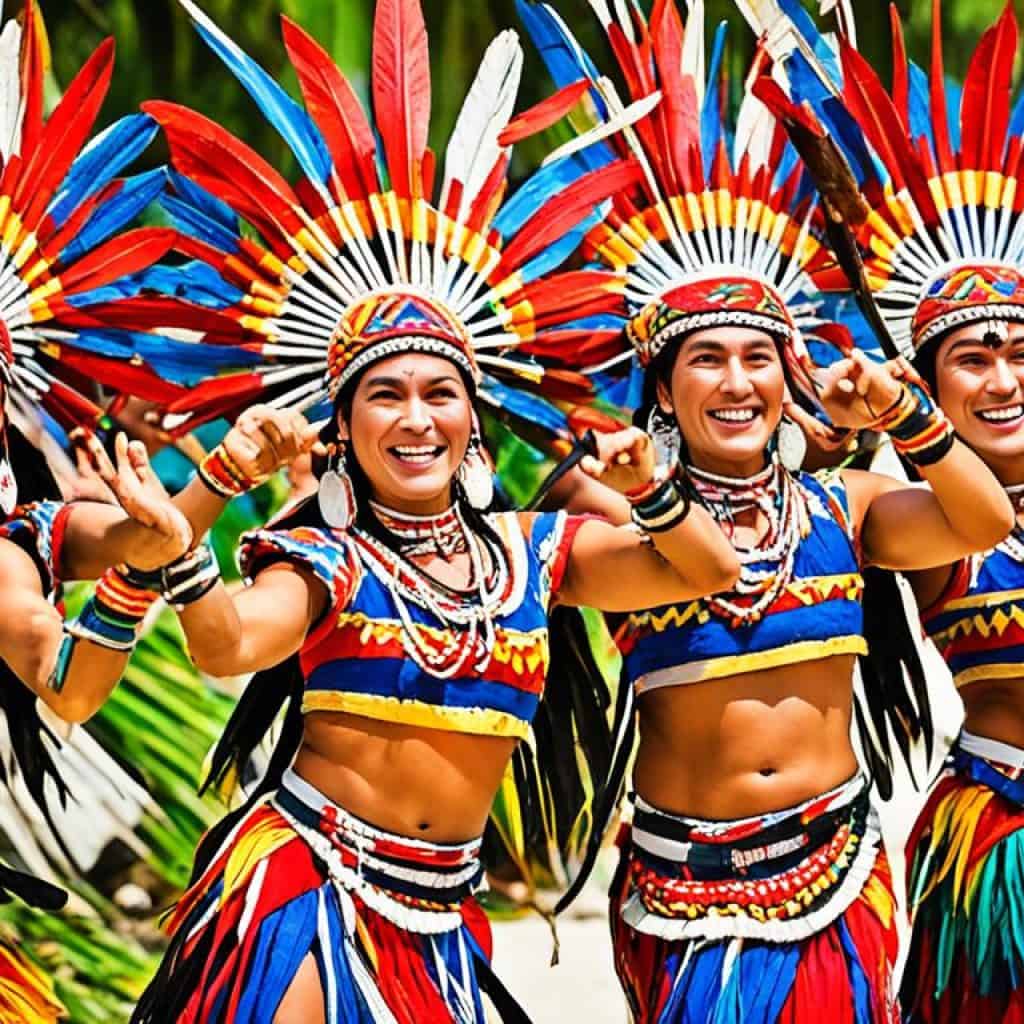
Visiting the Ati-Atihan Festival
If you’re planning a trip to Boracay, be sure to schedule your visit during the Ati-Atihan Festival. The festival usually takes place in January, with the grandest celebrations happening on the third Sunday of the month. It’s a captivating experience that allows you to witness the captivating performances of tribal dance and music and be part of the joyful revelry.
Immerse yourself in the vibrant traditions and cultural expressions of the Ati people at the Ati-Atihan Festival. It’s a feast for the senses and a testament to the unique heritage that makes Boracay truly distinctive.
Preserving Aklanon Culture
The Ati-Atihan Festival not only serves as a major attraction for tourists but also plays a vital role in preserving and promoting Aklanon culture. It is a significant platform for the Ati people to showcase their ancestral practices and keep their traditions alive. The festival serves as a source of pride and identity for the local community, reinforcing their cultural roots and fostering a sense of unity.
Through the Ati-Atihan Festival and other cultural initiatives, the people of Aklan continue to pass down their heritage to future generations. This commitment to preserving Aklanon culture ensures that the cultural fabric of the province remains vibrant and thriving.
| Key Highlights of Aklanon Culture | Location | Celebration |
|---|---|---|
| Ati-Atihan Festival | Boracay Island | January, grandest celebrations on the third Sunday |
Sunsets
Boracay Island is renowned for its mesmerizing sunsets that leave visitors in awe. As the sun slowly descends below the horizon, a breathtaking display of vibrant colors paints the sky, creating a picturesque backdrop for unforgettable moments. Whether you’re enjoying a romantic evening or seeking a peaceful moment of solitude, watching the sunset on the beach is an experience that embodies the beauty and tranquility of Boracay.
The sunsets over Boracay Island are truly magical. The golden hues melt into shades of orange, pink, and purple, casting a warm glow that envelops the entire landscape. The tranquil sea reflects these stunning colors, creating a mirror-like effect that enhances the overall beauty of the scene. Every evening, locals and tourists gather on the beach to witness this natural spectacle, creating a sense of unity and appreciation for the wonders of nature.
There’s something undeniably romantic about watching the sun disappear into the horizon as the sky transforms into a canvas of breathtaking colors. Couples walking hand in hand along the beach, photographers capturing the perfect shot, and families cherishing precious moments together – all are captivated by the beauty of Boracay’s sunsets. Whether it’s a romantic date, a special celebration, or simply a serene moment of reflection, these sunsets create memories that last a lifetime.
The combination of Boracay’s stunning natural landscapes, crystal-clear waters, and vibrant sunsets make it an ideal destination for those seeking beauty and tranquility. It’s no wonder that travelers from around the world are drawn to Boracay Island to witness these awe-inspiring sunsets and immerse themselves in the peaceful ambiance that surrounds them.
Island Geography
Boracay Island, located in the Western Visayas region of the Philippines, is a stunning tropical paradise renowned for its breathtaking beauty and pristine beaches. Spanning a total land area of 10.32 square kilometers, Boracay is situated within the province of Aklan and is divided into three barangays: Balabag, Manoc-Manoc, and Yapak.
The island boasts a highest elevation of 302 feet, with its summit known as Mount Luho, offering panoramic views of the surrounding archipelago. Nestled amidst the crystal-clear waters of the archipelago, Boracay Island is a jewel in the region, attracting visitors from around the world.
Located at coordinates 11°58’8″N latitude and 121°55’26″E longitude, Boracay’s perfect geographic position contributes to its remarkable climate and stunning natural landscapes, making it a true tropical paradise.
Geographical Features of Boracay Island:
| Aspect | Details |
|---|---|
| Location | Western Visayas region of the Philippines |
| Province | Aklan |
| Barangays | Balabag, Manoc-Manoc, Yapak |
| Total Land Area | 10.32 square kilometers |
| Highest Elevation | 302 feet |
| Highest Point | Mount Luho |
| Coordinates | 11°58’8″N 121°55’26″E |
Recognition and Awards
Boracay Island has garnered widespread recognition and numerous awards, solidifying its reputation as one of the best islands in the world. The island’s pristine beauty and captivating attractions have captured the hearts of travelers and industry experts alike, earning it a place on the global stage.
“Boracay, often referred to as the ‘crown jewel of the Philippines,’ has consistently stood out as an extraordinary destination.” – Travel + Leisure
In 2012, Boracay was named the Best Island in the World by Travel + Leisure, showcasing its unparalleled natural beauty and captivating experiences. This accolade recognized Boracay’s breathtaking beaches, azure waters, and vibrant culture that continue to captivate visitors from around the globe.
Conde Nast Traveler, a leading travel publication, also lauded Boracay, placing it at the top of the Best Islands in the World list in 2014. This accolade further cemented Boracay’s status as a premier travel destination.
Boracay’s recognition doesn’t stop there. The island has been consistently featured in various top destinations to watch lists, drawing attention from travelers and enthusiasts seeking exceptional experiences. Its stunning landscapes, crystal-clear waters, and vibrant culture make it an alluring choice for those craving a tropical paradise.
With its well-deserved recognition and a string of prestigious awards under its belt, Boracay Island continues to shine as one of the world’s most sought-after destinations.
Closure and Rehabilitation
In 2018, Boracay Island underwent a major closure and rehabilitation period in response to environmental concerns and the need for significant renovation works, particularly regarding the outdated sewage system. Recognizing the necessity for action, the Philippine government, under the leadership of President Rodrigo Duterte, implemented a six-month closure to address these issues and restore the island’s natural beauty.
During the closure, the Boracay Inter-agency Task Force took charge of managing the rehabilitation efforts, ensuring that the necessary renovations were carried out efficiently and effectively. This task force consisted of various government agencies collaborating to oversee the closure and implement new measures for the island’s sustainable development.
The main focus of the renovation works was the improvement of the sewage system. The outdated system posed a threat to the island’s environment, highlighting the need for immediate action. By upgrading and modernizing the sewage system, Boracay Island could address this environmental concern and protect its natural resources.
After six months of closure and rehabilitation, Boracay Island officially reopened in October 2018. The implementation of new rules and regulations ensured the sustainable development and preservation of the island’s beauty for future generations to enjoy. The closure and rehabilitation marked a significant milestone in Boracay’s journey towards environmental sustainability, promoting responsible tourism and showcasing the importance of preserving natural wonders for posterity.
Boracay’s closure and rehabilitation serve as a testament to the commitment of the Philippine government and its stakeholders to protect and revitalize the island’s ecosystem. Through the collaboration of various agencies and the determination to address environmental concerns, Boracay Island has emerged as a shining example of successful rehabilitation and sustainable development.
In the next section, we will delve into the vibrant celebration of the Boracay Ati-Atihan Festival and its significance in highlighting the cultural heritage of the island.
Boracay Ati-Atihan Festival
The Boracay Ati-Atihan Festival is a vibrant celebration held annually in honor of the indigenous Ati people. This cultural event has become a major draw for tourists, attracting a record-breaking number of participants in 2024. With its rich cultural heritage and colorful traditions, the festival has solidified its status as a significant attraction for both locals and visitors.
The Boracay Ati-Atihan Festival showcases the unique dance and music of the Ati people, accompanied by vibrant parades filled with revelers in elaborate costumes. This lively event provides an immersive experience into the local culture and offers a glimpse into the island’s indigenous roots. It is a vibrant display of tradition, unity, and joy.
The Boracay Ati-Atihan Festival is more than just a gathering; it is a celebration of our cultural heritage and a testament to the island’s vibrant spirit. Through dance, music, and parades, we are able to share the Ati people’s traditions with the world and create lasting memories for both locals and tourists. – Local Festival Organizer
As one of the major tourism attractions in Boracay, the Ati-Atihan Festival continues to captivate audiences with its lively performances and immersive cultural experience. The festival’s growing popularity is expected to further elevate Boracay’s position as a top travel destination in the coming years.
Join the festivities and immerse yourself in the vibrant traditions of the Ati people at the Boracay Ati-Atihan Festival. Experience the rhythm of the drums, admire the vibrant costumes, and celebrate the diversity of cultures that make Boracay a truly unique destination.
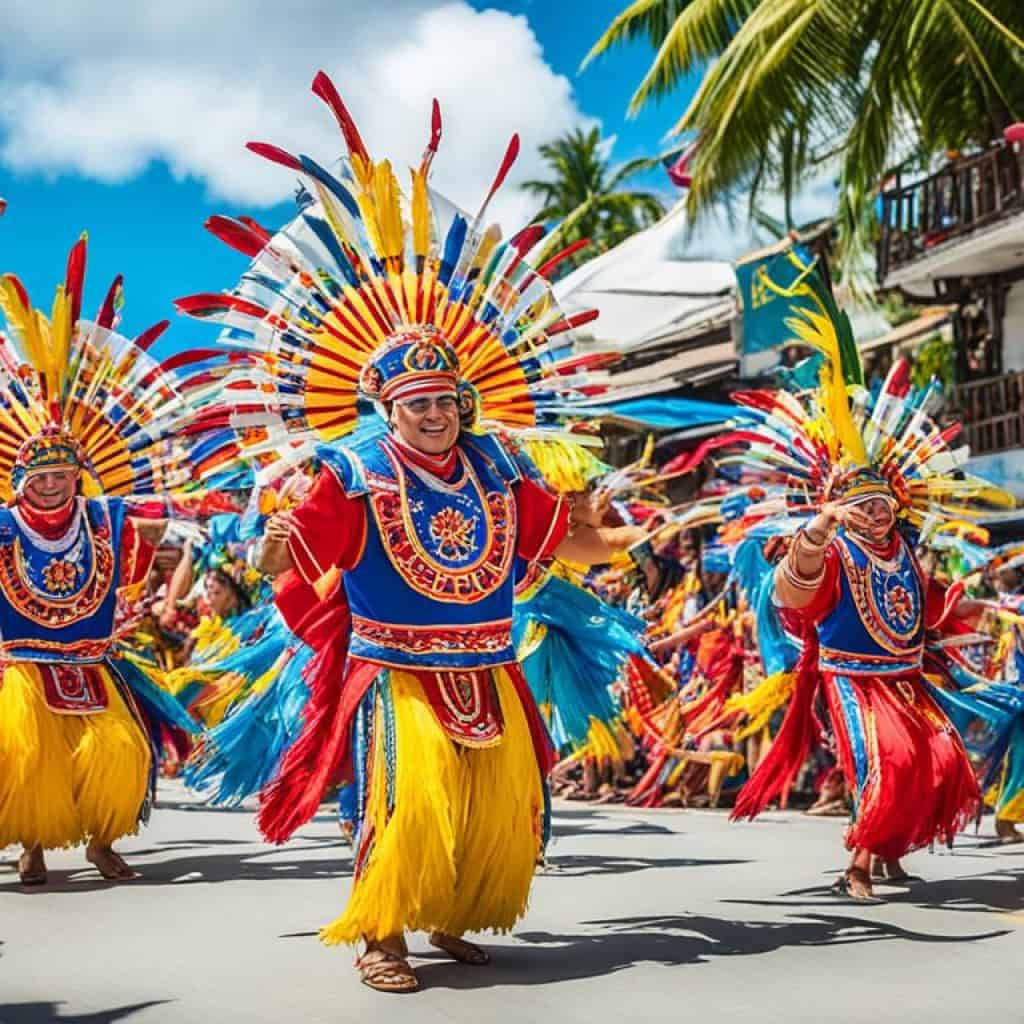
Etymology
The name Boracay has different origins according to various sources. The indigenous Ati people believe it comes from their words for “bubbles” and “white.” Another theory suggests that it is derived from the local word for “white cotton,” referencing the color and texture of the island’s sand. There is also a theory that links the name to the words for “shell” and “seed.” The exact origin of the name is still debated.
“Boracay” is believed to have multiple origins. The Ati people, who are the indigenous inhabitants of the island, have their own interpretation of the name. According to their language, “bora” means “bubbles” and “cay” means “white,” referring to the bubble-like white sand that covers the beaches. Another possibility is that “Boracay” is derived from the local word for “white cotton” due to the resemblance of the sand to the texture and color of cotton. Additionally, some suggest that the name might be related to the words for “shell” and “seed,” which are prominent features of the island’s natural surroundings. Regardless of its exact origin, the name “Boracay” encapsulates the beauty and uniqueness of this tropical paradise.
As a result of these diverse interpretations, the true meaning behind the name Boracay remains a subject of ongoing discussion and exploration.
Pre-colonial Period
Before the Spanish colonization of the Philippines, Boracay Island was home to the indigenous Ati people. The Ati people cultivated rice on the island, showcasing their agricultural skills and sustenance practices. With a population of about 100 people, the Ati community thrived on the natural resources found on Boracay.
During the pre-colonial period, another group known as the Tumandok people also established a presence on the island. The identities of the Ati and Tumandok people are often conflated, as there was cultural exchange and interaction between the two groups.
It is fascinating to observe the rich history and cultural heritage of Boracay Island, with the Ati people playing a significant role in its pre-colonial era. The cultivation of rice by the Ati community showcased their agricultural prowess and emphasized their deep connection to the land.
Inhabited by the Ati People
The Ati people were the earliest known inhabitants of Boracay Island, residing there long before the arrival of the Spanish colonizers. Their presence on the island demonstrates a deep-rooted connection to the land and a sustainable way of life.
Cultivation of Rice
One of the notable activities carried out by the Ati people on Boracay Island was rice cultivation. Through their agricultural practices, they were able to sustain their community and ensure a stable food supply. The cultivation of rice demonstrated their ingenuity and knowledge of farming techniques.
The Tumandok People
The Tumandok people, another indigenous group, also established a presence on Boracay Island during the pre-colonial period. Their arrival added to the cultural diversity of the island and contributed to its rich historical tapestry.
| Pre-Colonial Period | Boracay Island |
|---|---|
| Inhabitants | Ati people |
| Main Activity | Cultivation of rice |
| Additional Presence | Tumandok people |
“The cultivation of rice by the Ati people showcased their agricultural prowess and emphasized their deep connection to the land.”
Contemporary Period
Boracay Island, once a predominantly agricultural community, experienced a significant transformation with the emergence of tourism. In the past, copra production and the fishing industry played major roles in the island’s economy. However, the overharvesting of marine resources and the destruction of coral reefs led to a decline in the fishing industry, posing a challenge for the local community.
By the 1980s, recognizing the potential of tourism as an alternative source of income, Boracay began to flourish in the tourism sector. This shift was further encouraged when President Ferdinand Marcos declared Boracay as a tourist zone in 1978, leading to its development as a popular tourist destination.
With its stunning natural beauty and pristine beaches, Boracay attracted visitors from around the world, spurring the growth of resorts, hotels, and various tourist-related businesses. The development of the tourism sector brought new opportunities for the local community, offering jobs and economic prosperity.
Impact on the Local Community
The shift from an agricultural community to a tourist destination had both positive and negative impacts on the local community of Boracay. While tourism brought economic growth and employment opportunities, it also presented challenges and changes to the traditional way of life.
The increased demand for infrastructure and services to support tourism led to the displacement of some local residents and the loss of agricultural land. The shift from traditional occupations, such as farming and fishing, to jobs in the tourism industry created a new dynamic within the community.
“The growth of tourism has provided us with better opportunities, but it’s important that we find a balance between development and preserving our cultural heritage and natural resources.” – Local Community Leader
The local community of Boracay continues to navigate the complexities of maintaining its cultural identity and preserving the island’s natural resources while embracing the opportunities that tourism brings.
2018 Closure and Redevelopment
In 2018, Boracay Island underwent a much-needed closure and redevelopment period, driven by mounting environmental concerns, particularly the outdated sewage system. The Philippine government, led by President Rodrigo Duterte, took decisive action to address these issues and ordered a six-month closure of the island. This closure allowed for major renovation works to be undertaken, ensuring the long-term sustainability of Boracay’s natural beauty.
During the closure, the Boracay Inter-agency Task Force was established to manage the process and oversee the redevelopment efforts. This task force consisted of various government agencies working together to implement the necessary improvements and reforms. Their goal was to create a more environmentally-friendly and responsible tourism destination.
When Boracay reopened in October 2018, visitors were welcomed back to the island with new rules and regulations in place. These measures aimed to protect the environmental sustainability of the island and promote responsible tourism practices. The Philippine government’s commitment to long-term planning and development ensures that Boracay remains a world-class destination for years to come.
The closure and redevelopment of Boracay in 2018 marked a significant turning point for the island. By prioritizing environmental concerns and undertaking major renovation works, the Philippine government has demonstrated its commitment to preserving Boracay’s natural beauty for future generations. Visitors can now enjoy the island’s stunning beaches and vibrant culture while being mindful of their ecological impact. Boracay’s transformation serves as a shining example of how responsible tourism can lead to the sustainable development of a beloved tourist destination.
Conclusion
Boracay Island, located in the Visayan region of the Philippines, is a true tropical paradise and one of the best islands in the world. Its stunning beaches, such as the famous White Beach, with its powdery white sand, crystal-clear waters, and breathtaking sunsets, attract travelers from around the globe. But Boracay has so much more to offer than just its breathtaking natural beauty.
For thrill-seekers, there are exciting water sports activities like stand up paddle, kite surfing, snorkeling, and scuba diving. The island’s vibrant culture is showcased through its lively Ati-Atihan Festival, and its gastronomic delights that range from local flavors to international cuisines, including indulgent feasts like the boodle fight.
Despite undergoing a closure and redevelopment period in 2018, Boracay has come back stronger than ever, with a renewed focus on sustainability and environmental preservation. Whether you’re looking for relaxation or adventure, Boracay offers something for everyone. So, pack your bags and get ready for an unforgettable experience in this tropical paradise.
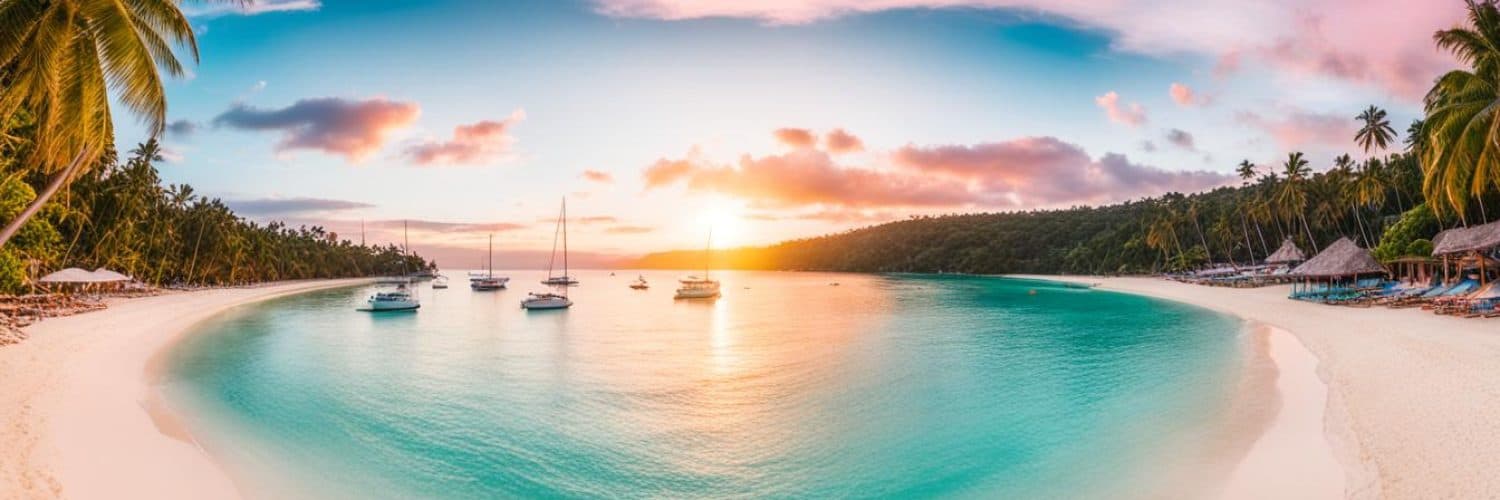
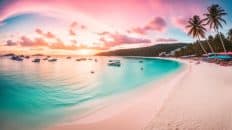
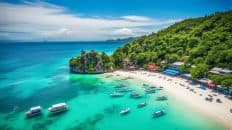
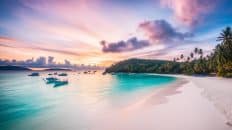














Add comment